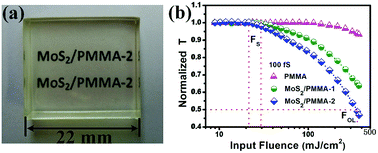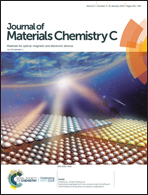Optical limiting properties of a few-layer MoS2/PMMA composite under excitation of ultrafast laser pulses
Abstract
MoS2/PMMA composite bulks have been successfully fabricated by homogeneously incorporating 2D layered MoS2 nanosheets into solid-state PMMA. The ultrafast nonlinear optical (NLO) properties of these MoS2/PMMA composite bulks excited by 800 nm ultrafast laser sources in the picosecond (ps) or femtosecond (fs) domains were investigated systematically for the first time. The dependence of optical-limiting performance with respect to the MoS2 concentration in the samples and the excitation pulse duration was studied in detail. It was found that the optical-limiting response increases with the concentration of MoS2 nanosheets in the PMMA matrix, and it decreases with the excitation pulse duration, respectively. The optical-limiting response under 100 fs excitation was much stronger than that under the 10 ps excitation pulse. Upon excitation by 100 fs laser pulses, the MoS2/PMMA composite exhibits an optical limiting starting threshold of 21.5 mJ cm−2, an optical limiting threshold of 315.1 mJ cm−2, and a limiting differential transmittance of 1.6%, respectively, and these values, to the best of our knowledge, are lower than those of other bulk nanomaterials, such as Fe2O3, C60, or Se doped silica xerogel, reported previously with a similar transmittance level (85%). These results have opened the door for highly efficient 2D-dichalcogenides/PMMA composite based optical limiters for ultrafast laser pulses and have great practical significance for the manufacture of high-quality solid-state optical limiters with low optical loss, high reliability and low cost.

- This article is part of the themed collection: 2019 Journal of Materials Chemistry C HOT Papers


 Please wait while we load your content...
Please wait while we load your content...